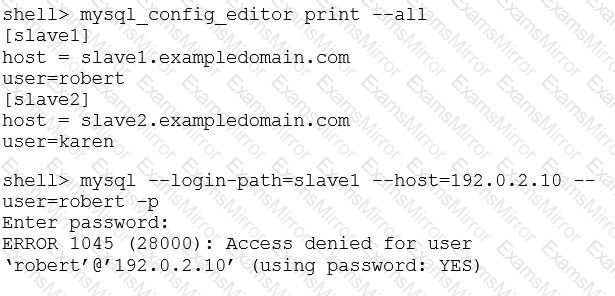Big Halloween Sale Limited Time 70% Discount Offer - Ends in 0d 00h 00m 00s - Coupon code = simple70
Pass the Oracle MySQL Database Administration 1z0-888 Questions and answers with ExamsMirror
Exam 1z0-888 Premium Access
View all detail and faqs for the 1z0-888 exam
451 Students Passed
90% Average Score
90% Same Questions
Which two statements describe how InnoDB recovery works? (Choose two.)
While attempting to set up a new replication slave on host ‘192.168.0.25’ with the user ‘replication’, you encounter this error:

What should you do to resolve this error?
This output is from a SHOW SLAVE STATUS:

What would cause the SQL_Delay variable to have a value of 360?
You have forgotten the root user account password. You decide to reset the password and execute:

Which additional argument makes this operation safer?
Which two are considered good security practices when using passwords? (Choose two.)
A MySQL instance is running on a dedicated server. Developers access the server from the same network subnet. Users access the database through an application that is running on a separate server in a DMZ.
Which two will optimize the security of this setup? (Choose two.)
You need to dump the data from the master server and import it into a new slave server.
Which mysqldump option can be used when dumping data from the master server in order to include the master server’s binary log information?
Host slave1 has ip address 192.0.2.10.
Host slave2 has ip address 203.0.113.50
Examine these commands:

Why did this error occur?
You are creating a strategy for backing up MySQL using a cold binary backup. The MySQL instance is a replication master with global transaction identifiers (GTIDs) enabled and it uses Transparent Data Encryption (TDE). Other than the configuration required to make the instance a replication master and enabled GTIDs and TDE, the instance is using all default settings.
The requirements for the backup are:
It must be possible to rebuild the instance using the backup.
It must be verified.
It must allow for a catastrophic hardware failure.
Which four steps must be included in the backup strategy? (Choose four.)
A MySQL replication slave is set up as follows:
Uses all InnoDB tables
Receives ROW-based binary logs
Has the read-only option
The replication slave has been found in an error state.
You check the MySQL error log file and find these entries:

What are two possible causes for this error to occur? (Choose two.)
TOP CODES
Top selling exam codes in the certification world, popular, in demand and updated to help you pass on the first try.
